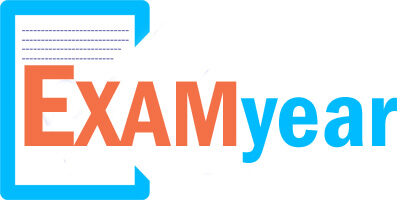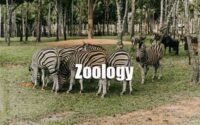GATE Zoology Question Papers
In this Article, we have provided the GATE Zoology Question Papers along with Solutions. So, the interested candidates who applied for jobs in GATE Zoology can download GATE Zoology Question Papers for free of cost. Get all the GATE Zoology Question Papers with just one click. Click on the enclosed links below to download the GATE Zoology Question Papers.

Check the Last five years GATE Zoology Question Papers to get a clear idea of the exam pattern. Along with GATE Zoology Question Papers, it’s better to refer GATE Zoology Syllabus & Exam Pattern before starting preparation. So, click on link to check and download GATE Zoology Question Papers PDF.
Question Papers of GATE Zoology
1. DNA with right handed helix, 11 base pair per turn and angle of rotation per base is nearly 32.7° called
(1) A-DNA
(2) B-DNA
(3) C-DNA
(4) Z-DNA
2. A group of membrane bound cell organelles is
(1) Endoplasmic reticulum, ribosomes, nucleus
(2) Chromosomes, ribosomes, endoplasmic reticulum
(3) Ribosomes, Golgi bodies, endoplasmic reticulum
(4) Lysosomes, Golgi complex, mitochondria
3. Calcium dependent kinases can control
(1) cell surface receptors
(2) cell cycle activities
(3) DNA replication
(4) spindle fibres
4. Combination of histone molecules that combines with the DNA to form the nucleosome core are :
(1) HIA, HIB, H2, H3
(2) H1, H2A, H2B, H3
(3) H1, H2, H3, H4
(4) H2A, H2B, H3, H4
5. Which one of the following biomolecule is correctly characterised ?
(1) Palmitic acid : an unsaturated fatty acid with 18 carbon atom.
(2) Adenylic acid : adenosine with a glucose phosphate molecule.
(3) Alanine amino acid : contains an amino group and no acidic group in the molecule.
(4) Lecithin : a phosphorylated glyceride found in cell membrane
6. Hatchek pit in Amphioxus is present at
(1) roof of oral cavity
(2) intestine
(3) vestibule
(4) anal opening
7. Paraffin wax is
(1) Acid
(2) Ester
(3) monohydric alcohol
(4) cholesterol
8. Which of the following fructose phosphate, when in low conc. stimulates gluconeogenesis ?
(1) Fructose-1 -phosphate
(2) Fructose-6-phosphate
(3) Fructose-1, 6-biphosphate
(4) Fructose-2, 6-biphosphate
9. A rare inherited glycogen storage disease is
(1) Philadelphia syndrome
(2) Jacob’s syndrome
(3) McArdle’s disease
(4) Hanson’s disease
10. The only enzyme that participates in both, Kreb’s cycle and electron transport chain is
(1) Hexokinase
(2) Aldolase
(3) succinate dehydrogenase
(4) cytochrome C oxidase
11. Chief end products of carbohydrate and fat metabolism are
(1) H2O and CO2
(2) H2O and pyruvic acid
(3) CO2 and pyruvic acid
(4) None of these
12. Which of the following is an essential fatty acid for vertebrates ?
(1) Tryptophan
(2) Lecithus
(3) Propionic acid
(4) Linoleic acid
13. Sphingosine :
(1) is a backbone of phosphoglycerides.
(2) is an amino alcohol with long chain of unsaturated hydrocarbons
(3) chain has a total of 40 carbons
(4) chain has C2 carbon with acidic group
14. Which of the following does not contribute in sugar metabolism ?
(1) Insulin
(2) Glucagon
(3) Cortisone
(4) Acetylcholinestrase
15. The enzyme which is not used during β-oxidation of fatty acids
(1) Acetyl CoA decarboxylase
(2) Thiolase
(3) Enoyl CoA hydratase
(4) β-hydroxy acetyl CoA dehydrogenase
16. In the absence of glucose or during prolonged starvation the energy source of the brain is
(1) Fat
(2) Ketone bodies
(3) Protein
(4) Lipids
17. Find the incorrect option with regard to type of cells present in a particular organ.
(1) Kupffer cells — Liver
(2) Chromaffin -— Adrenal gland cells
(3) Paneth cells – Kidney
(4) Somatotropic — Adenohypophysis cells
18. Prothrombin required for blood clotting is produced by
(1) Liver
(2) Pancreas
(3) Brain
(4) Spleen
19. The vitamin excreted by vertebrate kidney is
(1) A
(2) D
(3) C
(4) K
20. In vertebrates a protein material which is actual carrier of hormone, synthesised by neuro-secretary cells is called
(1) Vasopressin
(2) Neurophysine
(3) Oxytocin
(4) Eclosion
| Hard Questions | GK |
| Easy Questions | Quiz |
| Important Questions | Viva |
| TRB | MCQs |
| GATE | Sample Papers |
| JRF | Model Questions |
| NEET | Previous Papers |
| Objective |
21. Smallest muscle in human body
(1) Sartortus
(2) Stapes
(3) Stapedius
(4) Spinal muscles
22. Which one of the following enzyme is of outer mitochondril chamber ?
(1) NADH — cytochrome C reductase
(2) Adenylate kinase
(3) Malate dehydrogenase
(4) ATP — synthetase
23. The process which chloride ions pass into RBC and bicarbonate ions pass out is called
(1) Bicarbonate shift
(2) Chloride shift
(3) Buffer system
(4) Enzyme shift
24. Which of the given vitamins is also considered as a hormone ?
(1) Ascorbic acid
(2) Calciferol
(3) Thiamine
(4) Riboflavin
25. What change occurs in haemoglobin structure due to mutation that results in sickle cell anaemia ?
(1) glutamic acid in β-chain of globin is replaced by valine
(2) valine in β-chain of globin is replaced by glutamic acid
(3) glutamic acid in o-chain of globin is replaced by valine
(4) valine in a-chain of globin is replaced by glutamic acid
26. In birds the sex chromosomes are designated as
(1) X and Y chromosomes
(2) Z and W chromosomes
(3) X and Z chromosomes
(4) A and B chromosomes
27. Which of the following phenotypic ratio shows complementary gene interaction ?
(1) 15:1
(2) 1:2:1
(3) 9:3:3:1
(4) 9:7
28. In Human a single recessive trait which can express its effect should occur on
(1) any autosome
(2) X-chromosome of male
(3) X-chromosome of female
(4) any chromosome
29. Example of Y-linkage disease
(1) Haemophilia
(2) Hypertrichosis
(3) Pseudoricketes
(4) Eye colour in drosophila
30. Alkaptonuria, which is an inborn error of metabolism in human is due to
(1) lack of ability to breakdown homogentisic acid
(2) accumulation of phenyl pyruvic acid
(3) Incapability of converting dihydroxyphenylalamine into melanin
(4) Accumulation 2, 5 — dihydroxyphenyl pyruvic acid
31. Holandric genes are carried by
(1) X chromosome
(2) Different parts of Y chromosome
(3) X and Y chromosomes both
(4) Autosomes
32. Development of unrelated groups of animals along parallel lines in adaptation to a similar environment is called
(1) Adaptive convergence
(2) Adaptive radiation
(3) Adaptive divergence
(4) Adaptive induction
33. Cortical granules in egg are made up of
(1) Melanin
(2) Mucopolysaccharide
(3) Albumin
(4) Lipoprotein
34. Nebenkern is a part of
(1) Ovary (human)
(2) Ovum
(3) Sperm (human)
(4) Kreb cycle
35. What type of egg membrane are the calcareous shell in hen’s and jelly in frog’s egg ?
(1) Primary
(2) Secondary
(3) Tertiary
(4) shell secondary and jelly primary
36. Cells of Rauber are
(1) Secretory cells of endometrium in uterus
(2) inner cell mass of blastocoel
(3) outer cells of trophoblast in contact with uterine wall
(4) cells of trophoblast, in contact with inner cell mass of blastocyst
37. Change in a chromosome during ageing is
(1) increase in length
(2) change in nucleotide
(3) shortening of the telomere length
(4) change in DNA sequence
38. Diploid parthenogenesis occurs in
(1) Honey bee
(2) Arachnids
(3) Artemia
(4) Lecanium putanami
39. “Spiral holoblastic” cleavage is not present in
(1) Nemertea
(2) tubellarian flatworm
(3) cephalopoda
(4) Trochus
40. How many extraembryonic membrane develops in the cleidoic egg ?
(1) Four
(2) Three
(3) Five
(4) Two
41. During development of chick 12-pairs of cranial nerves appear in the embryo of
(1) 72 hours
(2) 96 hours
(3) 24 hours
(4) 48 hours
42. Regeneration of complete individual from a small portion of Hydra is
(1) Morphollaxis
(2) Epimorphosis
(3) Physiological regeneration
(4) Compensatory hypertrophy
43. Deciduale placenta present in
(1) Cow
(2) Pig
(3) Human
(4) lemur
44. Which of the following Indian sites are included in UNESCO World Heritage Sites (Natural) ?
A. Great Himalayan National Park
B. Keoladeo National Park
C. Western Ghats
D. Manas Wildlife Sanctuary
Find the correct choice :
(1) Only A and C
(2) Only B, C, D
(3) Only A, B, D
(4) A,B, C and D
45. The phenomenon of increasing concentration of a toxic chemical in the tissues of organisms at successively higher levels in a food chain :
(1) Bioaccumulation
(2) Biotransformation
(3) Biomagnification
(4) Bioremediation
46. One of pattern of soil erosion caused by wind is
(1) Incineration
(2) Mulching
(3) Land slide
(4) Saltation
47. Constituents of biogas are
A. Hydrogen sulphide
B. Methane
C. Carbon dioxide
Select the correct answer :
(1) only A and B
(2) only B
(3) only B and C
(4) A, B and C
48. Gross primary productivity of an ecosystem is
(1) the rate of production of inorganic matter during metabolism.
(2) the rate of production of organic matter during photosynthesis.
(3) the rate of consumption of energy during respiration
(4) the rate of consumption of inorganic matter during metabolism.
49. Which is not a Ramsar site ?
(1) Rudrasagar lake
(2) Keoladeo National Park
(3) Sunderbans Wetland
(4) Ujini Wetland
50. Itai — Itai disease is caused by
(1) Pb
(2) Cr
(3) Cd
(4) Hg
51. Which of the following is used extensively in vermiculture ?
(1) Neanthes caudata
(2) Eisenia foetida
(3) Pheretima posthuman
(4) Lumbricus terrestris
52. Concept of innate releasing mechanism was given by
(1) Konard Lorenz
(2) Niko Tinbergen
(3) Darwin
(4) Pavlov
53. As per Thorpe, which of the following is not a flexible learning ?
(1) Habituation
(2) Latent learning
(3) Reasoning
(4) Imprinting
54. Incubation of bigger size eggs by Grey leg goose is an example of
(1) sign stimulus
(2) auditory stimulus
(3) supernormal stimulus
(4) chemical stimuli
55. Monarch and viceroy butterflies are the vivid examples of
(1) Parthenogenesis
(2) Parasitism
(3) mimicry
(4) social insects
56. Which one of the following is not true about Wernick’s area ?
(1) Located in right temporal lobe.
(2) It act as store house for vocabulary.
(3) It is responsible for understanding written language.
(4) It is responsible for understanding spoken language.
57. Which subclass of IgG cannot cross placenta easily ?
(1) IgGl
(2) IgG2
(3) IgG3
(4) IgG4
58. Associated with immune system, these dendritic cells are present in the skin :
(1) CD4 cells
(2) Langerhans cells
(3) NK cells
(4) T-cells
59. Which of the following is the human embryonic lung cell line ?
(1) HeLa
(2) MRC-5
(3) WISH
(4) L
60. Which of the following cells have a high affinity receptor for IgE in human ?
(1) Dendritic cells
(2) Langerhans cells
(3) Monocytes
(4) Basophils

